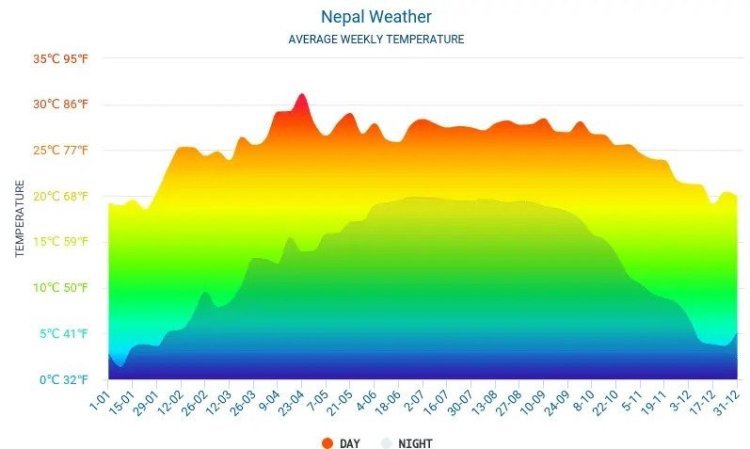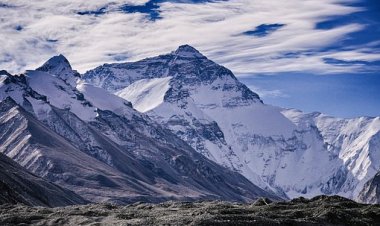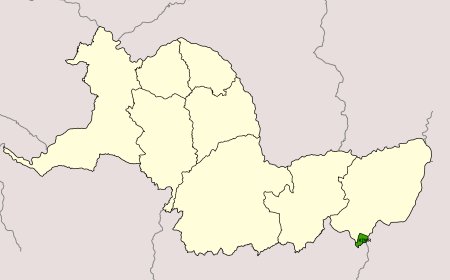The Rising Temperature in Kathmandu
Rising temperatures in Kathmandu pose significant challenges for residents, impacting health, infrastructure, and ecosystems, underscoring the importance of climate adaptation strategies and sustainable solutions.

Kathmandu, the bustling capital city of Nepal, experienced an alarming surge in temperatures during May and June 2023. With reports of the mercury climbing to a scorching 41 degrees Celsius, residents and experts alike were left questioning the underlying causes behind this unprecedented heatwave. In this article, we delve into the factors contributing to the soaring temperatures, examining the urban heat island effect, geographical influences, and the potential role of climate change. Furthermore, we explore the impacts and challenges faced by Kathmandu's inhabitants as they grapple with the adverse effects of rising temperatures.
-
Urban Heat Island Effect:
One key contributor to the intensifying heat in Kathmandu is the urban heat island effect. As the city rapidly expands and concrete structures dominate the landscape, they absorb and radiate heat, creating localized hotspots. The lack of green spaces and vegetation exacerbates this effect, leaving Kathmandu susceptible to higher temperatures compared to the surrounding rural areas.
-
Geographical Factors:
Kathmandu's geographical location plays a significant role in its climatic conditions. Nestled in the Kathmandu Valley and surrounded by hills, the city is prone to temperature inversions, where a layer of warm air gets trapped close to the ground. This geographical confinement, coupled with the lack of airflow, hampers natural cooling mechanisms, leading to increased heat retention within the city.
-
Climate Change:
While a single heatwave cannot be directly attributed to climate change, the overarching trend of rising temperatures globally may contribute to such extreme weather events. Nepal, like many other regions, has been witnessing changing weather patterns due to climate change, including more frequent heatwaves and altered monsoon rainfall patterns. These long-term shifts in climate can influence the occurrence and intensity of heatwaves in Kathmandu.
-
Topography and Elevation:
Kathmandu's location at a relatively high elevation contributes to its temperature patterns. While the city sits in a valley, it is surrounded by the Himalayan mountain range, which acts as a barrier to airflow. This geographical setup traps warm air and inhibits the dispersal of heat, leading to higher temperatures within the valley.
-
Air Pollution:
Kathmandu faces significant challenges in terms of air pollution, primarily due to vehicle emissions, industrial activities, and the burning of solid fuels for cooking and heating. This pollution creates a layer of particulate matter and smog, which absorbs and retains heat, further elevating the temperatures in the city.
-
Deforestation and Loss of Green Spaces:
The rapid urbanization and population growth in Kathmandu have resulted in the loss of green spaces and deforestation. Trees play a crucial role in regulating temperatures by providing shade and cooling through evapotranspiration. The reduction in green cover intensifies the urban heat island effect and contributes to higher temperatures.
-
Changes in Land Use:
The transformation of agricultural land and open spaces into built-up areas, along with the proliferation of concrete structures, leads to a decrease in the natural cooling effect provided by soil and vegetation. These changes in land use increase heat absorption and reduce the availability of natural cooling mechanisms, exacerbating the heat in Kathmandu.
-
Infrastructure and Heat-Trapping Materials:
The construction of buildings, roads, and other infrastructure using materials that have a high heat-absorbing capacity, such as concrete and asphalt, contributes to the retention and release of heat. The urban landscape of Kathmandu, dominated by such materials, can intensify the heat island effect and result in higher temperatures.

Impacts and Challenges:
The soaring temperatures in Kathmandu have far-reaching impacts on various aspects of life in the city:
-
Health Risks
High temperatures pose significant health risks, including heatstroke, dehydration, and respiratory issues. Vulnerable groups such as the elderly, children, and those with pre-existing health conditions are particularly at risk. -
Energy Consumption
As temperatures soar, the demand for cooling systems escalates, putting pressure on the already strained energy infrastructure. Increased energy consumption leads to higher carbon emissions, further exacerbating the effects of climate change. -
Agriculture
Rising temperatures can disrupt agricultural practices and impact crop yields. Changes in rainfall patterns and prolonged dry spells affect farming communities, jeopardizing food security and livelihoods. -
Water Resources
Extreme heat can intensify water scarcity as evaporation rates increase, putting stress on water resources. This can lead to challenges in ensuring an adequate supply of clean water for daily needs, agriculture, and sanitation. -
Urban Heat Stress
Rising temperatures in urban areas like Kathmandu can create a phenomenon known as urban heat stress. The combination of high temperatures, lack of ventilation, and heat-trapping materials can lead to uncomfortable and potentially dangerous living conditions, impacting the well-being and quality of life of residents. - Impact on TourismKathmandu is a popular tourist destination due to its rich cultural heritage and historical sites. However, extreme heat can deter tourists from visiting during peak summer months, impacting the tourism industry and the local economy.
-
Infrastructure Challenges
High temperatures can place stress on infrastructure systems. For instance, roads and buildings may suffer from thermal expansion, leading to cracks and structural damage. Additionally, increased energy demands for cooling systems can strain the power grid and infrastructure, leading to potential power outages and disruptions. -
Wildlife and Ecosystems
Elevated temperatures in urban areas can have adverse effects on wildlife and ecosystems. Habitats can be altered or degraded, affecting biodiversity and the balance of ecosystems. Wildlife populations may struggle to adapt to the changing climate conditions, further impacting the delicate ecological balance. -
Social and Economic Disparities
Heatwaves often disproportionately affect vulnerable communities, including those living in informal settlements and areas with limited access to cooling resources. The economic disparities within the city can exacerbate the challenges faced by marginalized communities, as they may lack the means to cope with extreme heat. -
Water and Sanitation
Heatwaves can intensify water scarcity and stress on water resources. This can impact access to clean water for drinking, sanitation, and hygiene practices. Additionally, increased temperatures can contribute to the proliferation of waterborne diseases, further compromising public health.
The high temperatures experienced in Kathmandu during May-June 2023 raised concerns about the changing climate dynamics and their impacts on the city. Addressing the causes and consequences of rising temperatures requires a comprehensive approach, including urban planning strategies to mitigate the urban heat island effect, promoting green spaces, and implementing climate adaptation measures. Furthermore, raising awareness about sustainable practices and fostering community resilience will be crucial in minimizing the adverse impacts of heatwaves and ensuring a more sustainable future for Kathmandu and its residents.
What's Your Reaction?




































































































